Vietnamese caramelized pork, also known as “Thit Kho To”, is a popular and flavorful dish that is enjoyed by many people around the world. This traditional Vietnamese dish consists of tender chunks of pork that have been marinated in a rich caramel sauce made with fish sauce, sugar, garlic, and other aromatic ingredients.
The pork is then slowly braised until it is tender and succulent, with a slightly sweet and savory flavor that is truly addictive. Vietnamese caramelized pork is often served with steamed rice and other side dishes, making it a comforting and satisfying meal that is perfect for any occasion. Whether you are a seasoned cook or a beginner in the kitchen, this dish is easy to make and will impress your family and friends with its delicious and complex flavors.
What is Vietnamese caramelized pork?
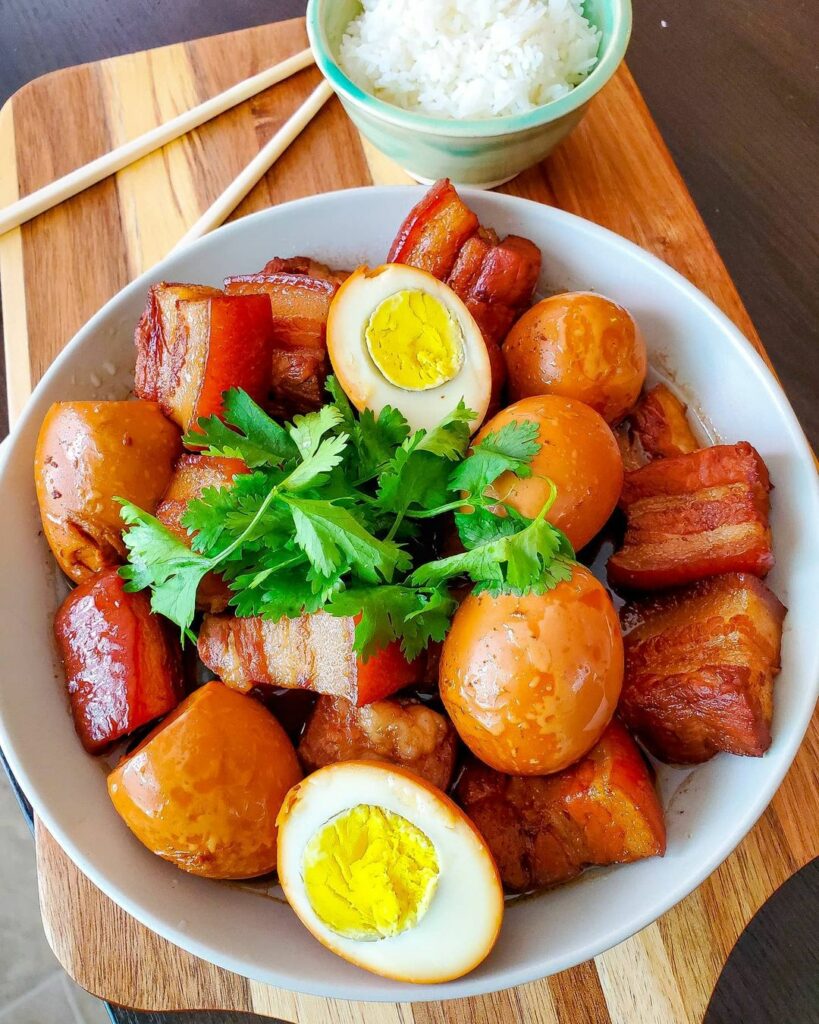
Vietnamese caramelized pork, also known as Thit Kho, is a popular and traditional dish in Vietnamese cuisine. The dish consists of chunks of pork that have been marinated in a rich caramel sauce made with fish sauce, sugar, garlic, shallots, and other aromatic ingredients. The pork is then slowly braised in the caramel sauce until it becomes tender and succulent, with a slightly sweet and savory flavor.
Vietnamese caramelized pork has a long history and cultural significance in Vietnamese cuisine. It is considered a comfort food and is often served during special occasions and festivals such as the Lunar New Year. The dish is believed to have originated in northern Vietnam, where it was originally made with beef or goat meat. However, over time, pork became the most popular meat used in the dish.
To make Vietnamese caramelized pork, you will need a few tools and equipment such as a large wok or heavy-bottomed pan, a sharp knife for slicing the pork, and a cutting board. It is also recommended to use a mortar and pestle to crush the garlic and shallots, but you can also use a food processor. Additionally, you will need measuring cups and spoons to accurately measure the ingredients for the marinade and caramel sauce.
Preparation to make Vietnamese caramelized pork
Before making thit kho recipe, it is important to prepare the pork and marinade properly to ensure the best flavor and texture. Here are the steps to prepare Vietnamese Caramelized Pork:
Vietnamese caramelized pork recipe
Cooking Note:
- Yield: 4-6 servings
- Prep time: 20 minutes
- Cook time: 1 hour and 30 minutes
- Total time: 1 hour and 50 minutes
- Course: Main dish
- Cuisine: Vietnamese
- Equipment: Large wok or heavy-bottomed pan, sharp knife, cutting board, mortar and pestle or food processor, measuring cups and spoons.
Ingredients:
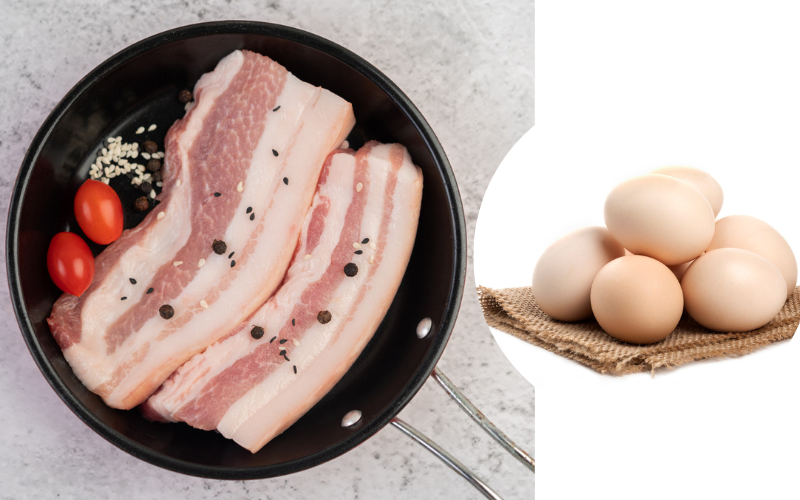
- 2 pounds of pork belly or shoulder, sliced into bite-sized pieces
- 1/2 cup of fish sauce
- 1/2 cup of sugar
- 2 cloves of garlic, minced
- 2 shallots, minced
- 1 tablespoon of vegetable oil
- 1 cup of water
Different ways to marinate the pork
- Use brown sugar or honey instead of white sugar for a richer flavor.
- Add chopped lemongrass or ginger to the marinade for extra aroma.
- Use coconut water or coconut milk instead of water to braise the pork for a creamier texture.
Tips for slicing the pork thinly and evenly
- Use a sharp knife to slice the pork against the grain for tender and easy-to-chew meat.
- Freeze the pork for 30 minutes before slicing to make it easier to handle and cut.
- Cut the pork into uniform-sized pieces to ensure even cooking.
Table of nutrient facts of Vietnamese caramelized pork
Here is a table of the estimated nutrient facts for Vietnamese caramelized pork:
| Nutrient | Amount |
| Calories | 369 |
| Total Fat | 27g |
| Saturated Fat | 9g |
| Cholesterol | 82 mg |
| Sodium | 1413 mg |
| Total Carbohydrates | 13g |
| Dietary Fiber | 0g |
| Sugars | 12g |
| Protein | 17g |
Please note that the nutrient facts may vary depending on the specific ingredients and cooking method used. This table is provided as an estimate and should not be used as a substitute for professional nutritional advice.
How to make Vietnamese caramelized pork?
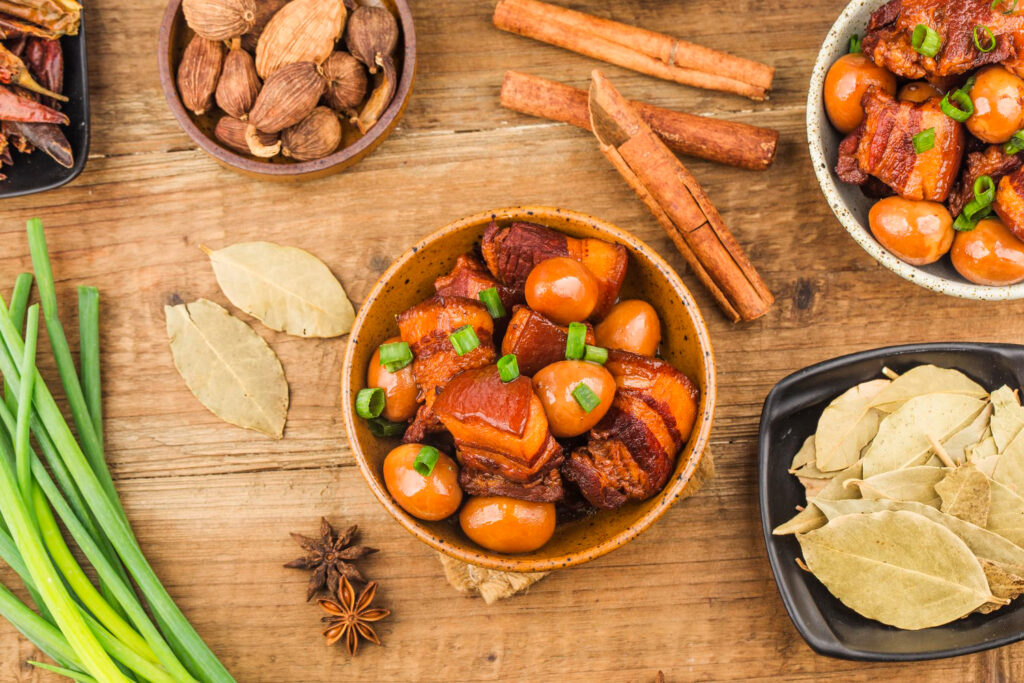
Vietnamese caramelized pork is a delicious and savory dish that is easy to make at home. Here are the steps to make Vietnamese caramelized pork, including how to make the caramel sauce:
How to make the caramel sauce?
- In a small saucepan, add the sugar and water.
- Heat the mixture over medium-high heat, stirring constantly, until the sugar has completely dissolved.
- Increase the heat to high and let the mixture boil without stirring until it turns a deep amber color. This should take about 10–15 minutes.
- Remove the pan from the heat and carefully pour in 1/4 cup of warm water. Be careful as the mixture will bubble up and steam.
- Stir the mixture until the caramel has completely dissolved in the water. Set aside until ready to use.
How to make Vietnamese caramelized pork?
- In a large bowl, mix together the fish sauce, sugar, garlic, and shallots until the sugar has completely dissolved.
- Add the pork to the bowl and mix until the pork is evenly coated with the marinade. Cover the bowl with plastic wrap and refrigerate for at least 2 hours or overnight.
- In a large wok or pot, heat the vegetable oil over medium heat.
- Add the marinated pork and stir-fry for about 10–15 minutes, or until the pork is browned and caramelized.
- Pour in the water and the caramel sauce, stirring to combine.
- Bring the mixture to a boil and then reduce the heat to low. Cover and simmer for 1-1.5 hours, or until the pork is tender and the sauce has thickened.
- Serve the Vietnamese caramelized pork hot with steamed rice and your choice of vegetables.
Alternative ingredient to make Vietnamese caramelized pork
While the traditional ingredients used to make Vietnamese caramelized pork are fish sauce, sugar, garlic, and shallots, some alternative ingredients can be used as substitutes or additions to give the dish a unique twist. Here are a few options:
- Hoisin sauce: This thick, sweet, and savory sauce is made from soybeans, sugar, and vinegar. It is a common ingredient in many Vietnamese dishes and can be used as a substitute or addition to fish sauce in the caramel sauce.
- Tamarind paste: This sour and tangy paste made from tamarind fruit can be added to the caramel sauce to give it a slightly different flavor profile.
- Ginger: Adding ginger to the marinade can add a spicy and slightly sweet taste to the pork.
- Lemongrass: This aromatic herb can be added to the marinade to give the pork a fresh and citrus flavor.
- Coconut water: Vietnamese braised pork with coconut water instead of using plain water to braise the pork, coconut water can be used to give it a subtle tropical taste. Vietnamese braised pork with coconut water
Alternatively, you can substitute the pork belly for Vietnamese caramelized pork loin to make Vietnamese-style braised pork.
These ingredients can be used in different combinations to create your own unique twist on the classic Vietnamese caramelized pork recipe. Experimenting with different flavors can be a fun way to create new and delicious dishes in the kitchen.
What are serving suggestions?
When it comes to serving Vietnamese caramelized pork, many options for sides and condiments can elevate the dish and create a well-rounded meal. While the classic combination of pork and steamed rice is a staple, there are a variety of other sides and condiments that can add different flavors and textures to the dish. Whether you prefer something light and refreshing or spicy and bold, there is a serving suggestion to fit your taste. Here are some recommended sides and condiments to try with your Vietnamese caramelized pork.
Recommended sides
- Steamed white rice: This is the classic side dish for Vietnamese caramelized pork, as it helps to absorb the rich and savory flavors of the dish.
- Pickled vegetables: A side of pickled carrots and daikon can provide a refreshing crunch and balance out the sweetness of the pork.
- Stir-fried vegetables: Bok choy, snow peas, and bean sprouts can be quickly stir-fried and served alongside the pork for a healthy and tasty addition.
- Spring rolls: Fresh or fried spring rolls filled with vegetables, herbs, and shrimp or pork can be a light and refreshing appetizer to serve alongside the main dish.
Recommended condiments
- Fish sauce dip: A simple dip made with fish sauce, water, sugar, and chili can provide a salty and spicy contrast to the sweetness of the pork.
- Sriracha or chili sauce: For those who prefer a spicier kick, adding some hot sauce can be a great way to bring some heat to the dish.
- Lime wedges: Squeezing a bit of fresh lime juice over the pork can help to brighten up the flavors and balance out the richness of the dish.
- Fresh herbs: Chopped cilantro, Thai basil, and mint can be sprinkled over the top of the pork for a fresh and herbaceous touch.
These sides and condiments can be mixed and matched to create your own perfect combination of flavors and textures to enjoy alongside the delicious Vietnamese caramelized pork.
What are variations of Vietnamese caramelized pork?
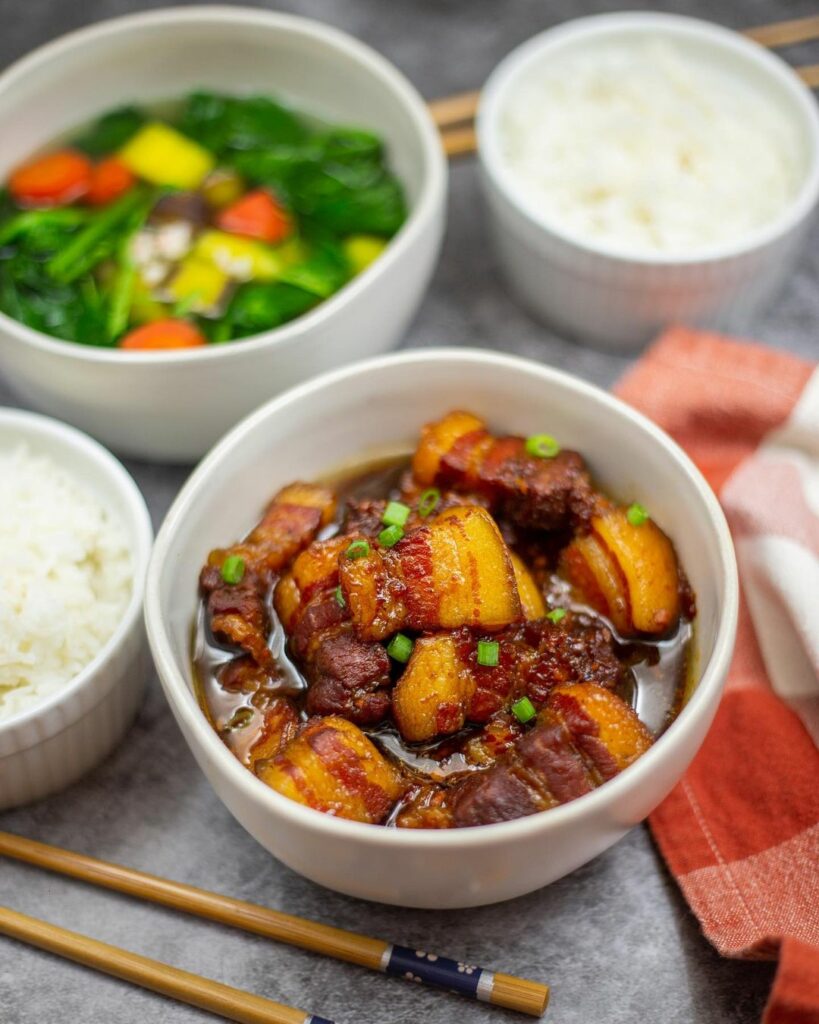
Vietnamese caramelized pork is a classic dish that has many variations and ways to customize the recipe. Here are some different ways to make the dish your own:
Customizing the dish
- Spicier: To add more heat to the dish, try adding sliced chili peppers, chili flakes, or chili oil to the marinade or sauce.
- Sweeter: If you prefer a sweeter flavor, use more sugar or substitute it with honey, maple syrup, or brown sugar.
- Tangier: To add a tangy kick to the dish, mix in some tamarind paste or lime juice with the marinade or sauce.
In addition to the non-Vietnamese style meat stock, you can also change it up by adding a few eggs to become Vietnamese pork belly and egg. However, the recipe remains the same, you just need to add eggs to make the dish more diverse.
Vegetarian and vegan alternatives
- Tofu: Replace the pork with firm tofu for a vegetarian version of the dish. Use the same marinade and cooking method for the tofu.
- Seitan: Another meat substitute that can be used instead of pork is seitan. Use the same marinade and cooking method as for the pork.
Using different cuts of pork
- Pork belly: The traditional cut of pork used in this dish is pork belly, but you can also use pork shoulder or other fatty cuts of pork.
- Ground pork: For a quicker and easier version of the dish, try using ground pork. Cook the pork in the caramel sauce and serve over rice.
- Lean pork: If you prefer a leaner option, use pork tenderloin or loin chops. Be careful not to overcook the meat, as it can become tough.
By using different ingredients and cuts of meat, you can create your own unique version of Vietnamese Caramelized Pork that suits your tastes and preferences.
Tips and tricks to make Vietnamese caramelized pork
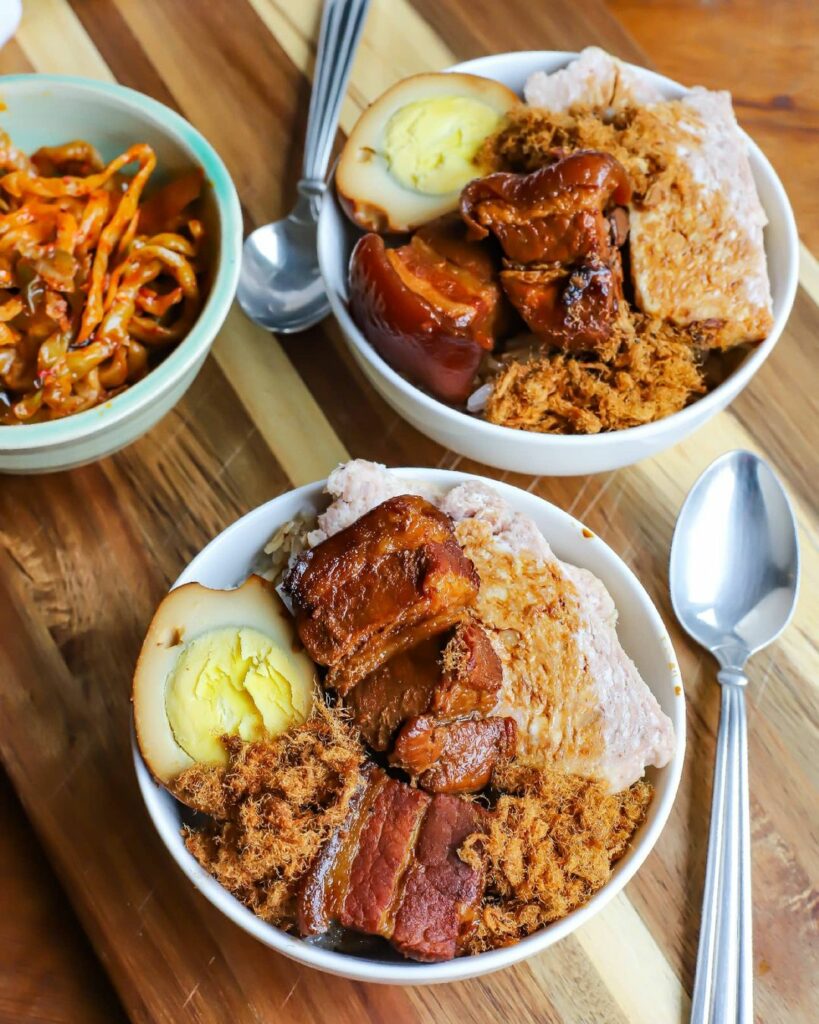
To help you make the perfect thit kho, here are some tips and tricks:
Common mistakes to avoid
- Overcooking the pork: Be careful not to overcook the pork, as it can become tough and chewy. Cook it until it is just tender and fully cooked.
- Burning the caramel sauce: Be sure to keep an eye on the caramel sauce, as it can quickly burn. Stir the sauce constantly and remove it from the heat once it has reached a deep amber color.
- Adding too much water: Adding too much water to the caramel sauce can dilute the flavors and prevent the sauce from thickening properly.
Tricks for achieving the perfect caramelization
- Use a heavy-bottomed pan: A heavy-bottomed pan will help distribute heat evenly and prevent the sauce from burning.
- Keep the heat low: Cook the pork over low heat to prevent the sauce from burning and to allow the flavors to develop slowly.
- Stir constantly: Stir the pork and sauce constantly to prevent the meat from sticking to the pan and to ensure the sauce coats the pork evenly.
Tips for meal planning and meal prep
- Make a large batch: Vietnamese Caramelized Pork can be easily reheated and makes for great leftovers, so consider making a large batch and storing it in the fridge or freezer for future meals.
- Serve with a variety of sides: Plan out which sides you want to serve with the dish and prepare them in advance to make mealtime easier.
How to store leftovers?
- Store in an airtight container: Once the pork has cooled, transfer it to an airtight container and store it in the fridge for up to 4 days or in the freezer for up to 3 months.
What is the best way to reheat Vietnamese caramelized pork?
- In the microwave: Place the pork in a microwave-safe container and heat on high for 1–2 minutes, or until heated through.
- On the stovetop: Heat the pork and sauce in a saucepan over low heat, stirring occasionally, until heated through.
By following these tips and tricks, you can make delicious and flavorful Vietnamese Caramelized Pork that is sure to be a hit at your dinner table.
Where can you buy pre-made Vietnamese caramelized pork?
If you don’t have the time or desire to make Vietnamese Caramelized Pork from scratch, you may be able to find thit kho instant pot versions of the dish at your local Asian grocery store or online. Look for brands that specialize in Vietnamese cuisine or other Asian food products. Some popular options may include:
- Lee Kum Kee: This brand offers pre-made sauces for Vietnamese caramelized pork that can be found in the Asian food section of many grocery stores.
- Savorly: Savory offers a pre-cooked version of Vietnamese caramelized pork that is sold in vacuum-sealed bags and can be found online.
- Meal delivery services: Some meal delivery services may offer Vietnamese caramelized pork as one of their meal options. Check with your favorite meal delivery service to see if it’s available.
- Goldbelly
- Grubhub
- DoorDash
- Uber Eats
These meal delivery services can be a convenient option if you don’t have the time or resources to make Vietnamese Caramelized Pork from scratch.
When buying pre-made Vietnamese Caramelized Pork, be sure to read the ingredients and nutritional information to ensure that it meets your dietary needs and preferences.
More pork belly recipe you can try at home: Vietnamese Boiled Pork Belly (Thit Luoc) for a Summer Feast
FAQs
Is Vietnamese caramelized pork gluten-free?
The traditional recipe for Vietnamese Caramelized Pork does not contain gluten. However, some pre-made sauces or marinades may contain gluten, so it’s important to check the labels carefully if you have a gluten allergy or intolerance.
Can I freeze Vietnamese caramelized pork?
Yes, Vietnamese Caramelized Pork can be frozen for up to 3 months. Store the pork in an airtight container or freezer bag and label with the date before placing it in the freezer. To reheat, thaw the pork in the fridge overnight and reheat on the stovetop or in the microwave.
Is thit kho and adobo the same?
Thit kho and adobo are both traditional meat dishes from Southeast Asia, but they are not the same. Thit kho is a Vietnamese dish made with caramelized pork and fish sauce, while adobo is a Filipino dish made with meat (usually chicken or pork) marinated in vinegar, soy sauce, and garlic before being stewed in the marinade.
By understanding these commonly asked questions, you can better appreciate and enjoy Vietnamese Caramelized Pork and other Southeast Asian dishes.
How long does it take to cook Vietnamese caramelized pork?
The cooking time for Vietnamese caramelized pork varies depending on the recipe and the size of the pork pieces. Generally, it takes around 20-30 minutes to cook the pork on medium-high heat, stirring occasionally, until it is fully cooked and coated in the caramelized sauce. It’s important to cook the pork until it reaches an internal temperature of 145°F (63°C) to ensure it is safe to eat.
What is the best cut of pork to use for caramelized pork?
The best cut of pork to use for Vietnamese caramelized pork is typically pork shoulder or pork belly. These cuts have enough fat to keep the meat moist and tender during cooking, while also providing a rich and flavorful base for the caramelized sauce.
However, other cuts of pork such as pork tenderloin or pork chops can also be used, but they may not be as tender or flavorful. Ultimately, the choice of cut will depend on personal preference and availability.
Is it necessary to marinate the pork before cooking?
It is not always necessary to marinate the pork before cooking Vietnamese caramelized pork, as the caramelized sauce will provide a lot of flavors.
However, some recipes may call for marinating the pork in a mixture of seasonings and sauces for several hours or overnight to enhance the flavor and tenderness of the meat. If you have the time and want to add an extra layer of flavor, marinating the pork is a good option. But if you’re short on time, you can skip the marinating step and still achieve a delicious dish.
How spicy is the typical Vietnamese caramelized pork recipe?
The spiciness level of a typical Vietnamese caramelized pork recipe can vary depending on the recipe and personal preference. Some recipes may include spicy ingredients such as chili flakes or Sriracha sauce, while others may not include any spicy elements at all.
If you prefer a spicy dish, you can add more chili flakes or hot sauce to the recipe to increase the heat level. On the other hand, if you prefer a milder dish, you can omit the spicy ingredients or reduce the amount used.
Can I adjust the level of sweetness in the caramelized sauce?
Yes, you can adjust the level of sweetness in the caramelized sauce to suit your taste. If you prefer a sweeter dish, you can increase the amount of sugar used in the recipe or add a bit of honey or maple syrup.
On the other hand, if you prefer a less sweet dish, you can reduce the amount of sugar used or use a sugar substitute such as stevia or erythritol. Keep in mind that adjusting the sweetness may also affect the overall flavor balance of the dish, so it’s important to taste the sauce as you adjust the sweetness to ensure it still tastes good.
Is this dish commonly served in Vietnamese restaurants?
Yes, Vietnamese caramelized pork is a common dish served in Vietnamese restaurants. It is a popular main course that is often served with steamed rice and vegetables or you can modify the recipe using pork belly to make pork belly banh mi.
How do I make the dish less sweet?
If you want to make Vietnamese caramelized pork less sweet, you can adjust the amount of sugar used in the recipe. Start by reducing the amount of sugar by a small amount, such as a tablespoon or two, and taste the sauce as you go to ensure that it still has enough sweetness to balance out the other flavors.
You can also add a bit of salt or soy sauce to the sauce to help balance out the sweetness. Additionally, you can use a sugar substitute such as stevia or erythritol in place of regular sugar to reduce the overall sweetness of the dish. Keep in mind that adjusting the sweetness may also affect the overall flavor balance of the dish, so it’s important to taste the sauce as you adjust the sweetness to ensure it still tastes good.
How do I prevent the pork from becoming tough?
To prevent the pork from becoming tough when making Vietnamese caramelized pork, it’s important to choose the right cut of pork and cook it correctly. Pork shoulder or pork belly is the best cut to use for this dish, as they have enough fat to keep the meat moist and tender during cooking. When cooking the pork, be sure to brown it on all sides before adding the liquid to the pan. This will help to seal the juices and keep the meat tender.
Additionally, be sure not to overcook the pork, but overcooking can cause it to become tough and chewy. Finally, you can also add a bit of liquid such as broth or water to the pan and cover it with a lid to help keep the pork moist and tender as it cooks.
Conclusion
Finally, Vietnamese caramelized pork is a delicious and savory dish that has a rich history and cultural significance in Vietnam. While the traditional recipe calls for a few simple ingredients, there are many variations and ways to customize the dish to suit your tastes and preferences. Whether you prefer it spicier, sweeter, or tangier, there are plenty of ingredients and cooking techniques you can use to make the dish your own.
In addition to its versatility and flavor, Vietnamese Caramelized Pork is also a convenient dish for meal planning and meal prep. While it’s certainly rewarding to make Vietnamese Caramelized Pork from scratch, there are also pre-made options available for those who don’t have the time or resources to make it themselves.
Just be sure to check the labels carefully to ensure that the dish is gluten-free if you have a gluten allergy or intolerance. Vietnamese Caramelized Pork is a flavorful and beloved dish that is sure to delight your taste buds and satisfy your hunger.